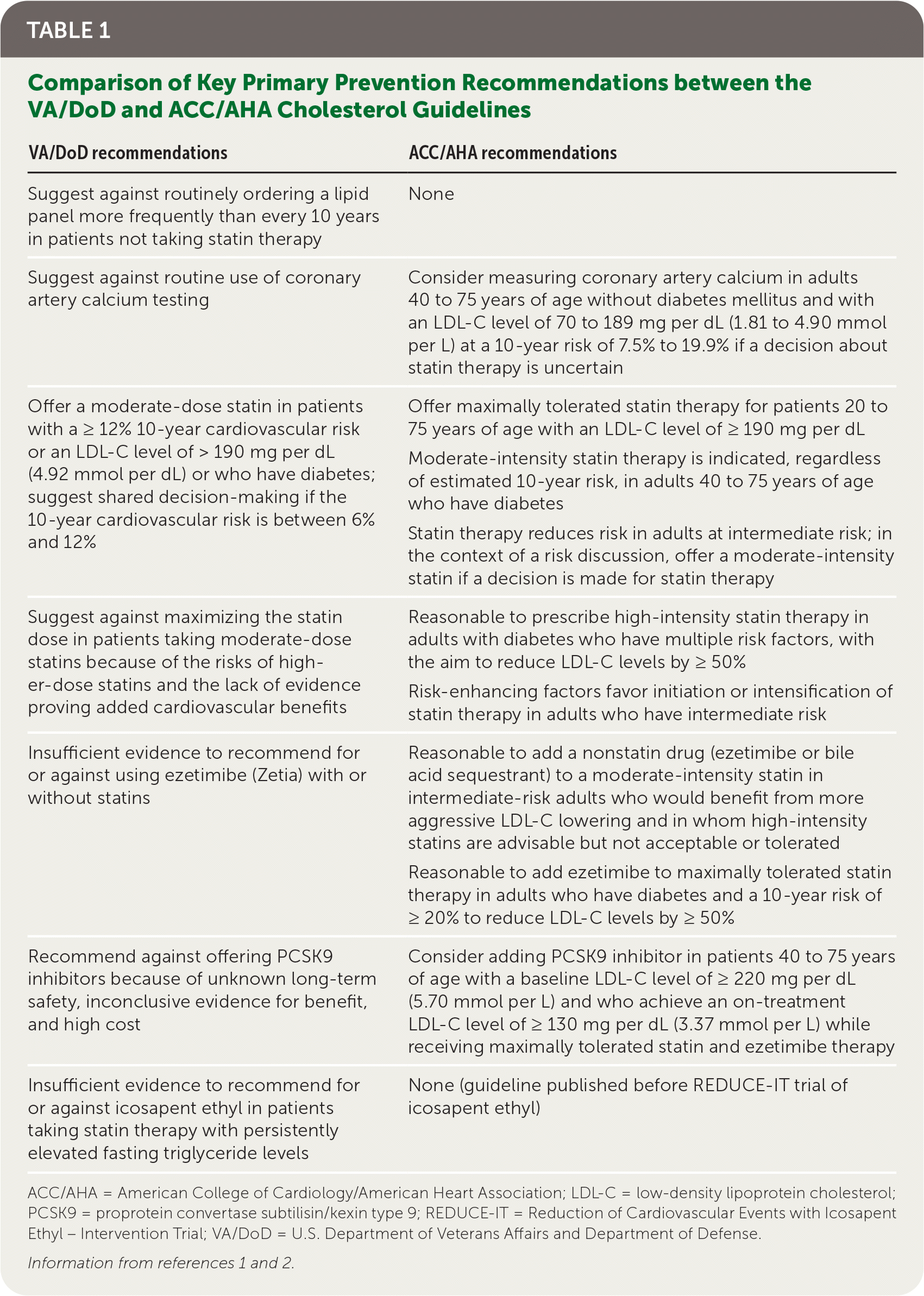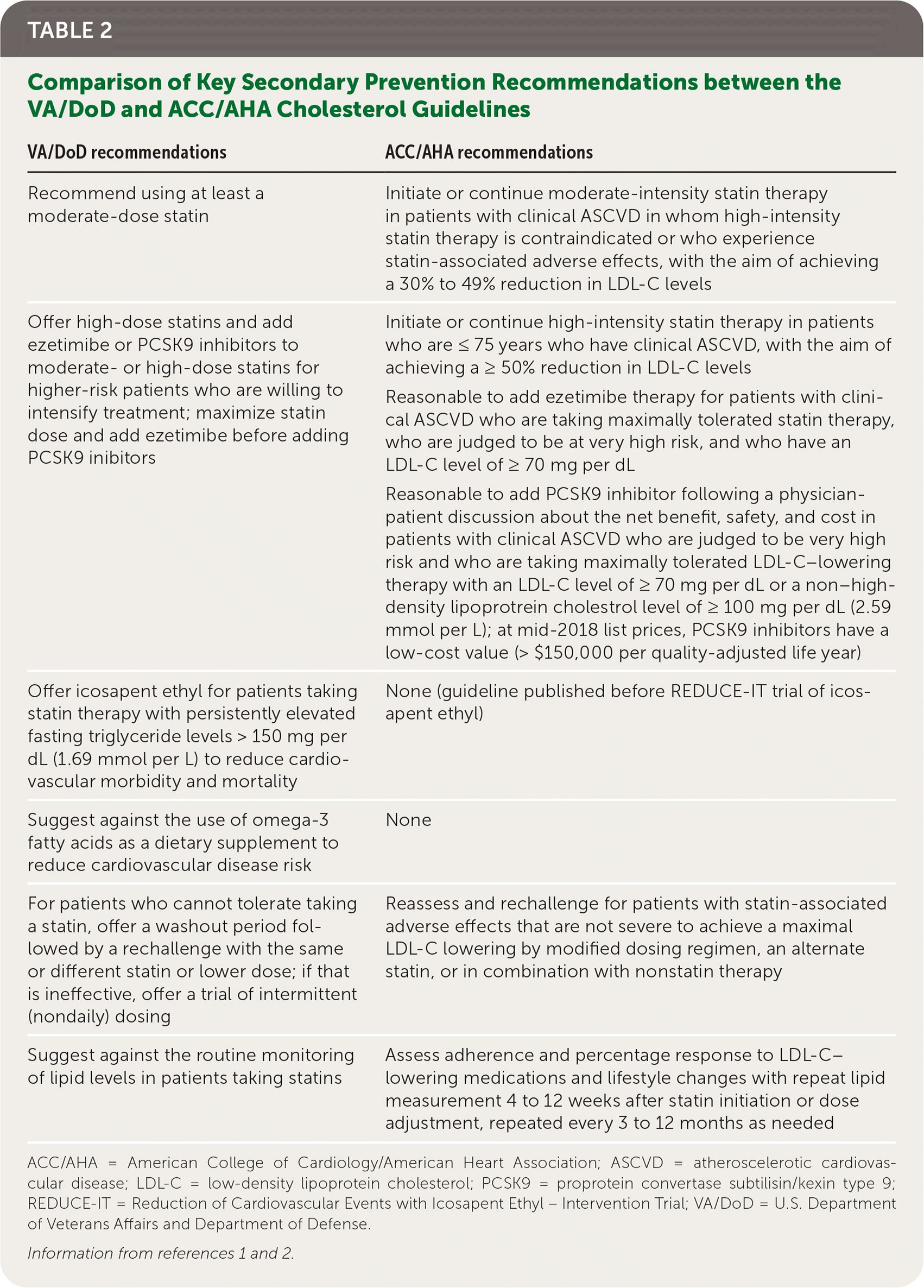
Am Fam Physician. 2021;103(8):455-458
Related practice guideline: Dyslipidemia Management for Cardiovascular Disease Prevention: Guidelines from the VA/DoD
Related letter to the Editor: USPSTF Recommendations for the Management of Dyslipidemia for Cardiovascular Risk Reduction
Author disclosure: No relevant financial affiliations.
The U.S. Department of Veterans Affairs and Department of Defense (VA/DoD), a health system with more than 20 million beneficiaries, has developed clinical practice guidelines over the past 25 years to promote straightforward, evidence-based care. In June 2020, the third iteration of the VA/DoD guidelines on managing dyslipidemia was published1 (see Figure 1 in the related practice guideline in this issue of American Family Physician). As members of the guideline working group, we believe that these recommendations create a simple, pragmatic, evidence-based approach that can be valuable to family physicians. Several of these guideline recommendations differ from those of the American College of Cardiology/American Heart Association (ACC/AHA; Table 1 and Table 2).1,2

| VA/DoD recommendations | ACC/AHA recommendations |
|---|---|
| Suggest against routinely ordering a lipid panel more frequently than every 10 years in patients not taking statin therapy | None |
| Suggest against routine use of coronary artery calcium testing | Consider measuring coronary artery calcium in adults 40 to 75 years of age without diabetes mellitus and with an LDL-C level of 70 to 189 mg per dL (1.81 to 4.90 mmol per L) at a 10-year risk of 7.5% to 19.9% if a decision about statin therapy is uncertain |
| Offer a moderate-dose statin in patients with a ≥ 12% 10-year cardiovascular risk or an LDL-C level of > 190 mg per dL (4.92 mmol per dL) or who have diabetes; suggest shared decision-making if the 10-year cardiovascular risk is between 6% and 12% | Offer maximally tolerated statin therapy for patients 20 to 75 years of age with an LDL-C level of ≥ 190 mg per dL Moderate-intensity statin therapy is indicated, regardless of estimated 10-year risk, in adults 40 to 75 years of age who have diabetes Statin therapy reduces risk in adults at intermediate risk; in the context of a risk discussion, offer a moderate-intensity statin if a decision is made for statin therapy |
| Suggest against maximizing the statin dose in patients taking moderate-dose statins because of the risks of higher-dose statins and the lack of evidence proving added cardiovascular benefits | Reasonable to prescribe high-intensity statin therapy in adults with diabetes who have multiple risk factors, with the aim to reduce LDL-C levels by ≥ 50% Risk-enhancing factors favor initiation or intensification of statin therapy in adults who have intermediate risk |
| Insufficient evidence to recommend for or against using ezetimibe (Zetia) with or without statins | Reasonable to add a nonstatin drug (ezetimibe or bile acid sequestrant) to a moderate-intensity statin in intermediate-risk adults who would benefit from more aggressive LDL-C lowering and in whom high-intensity statins are advisable but not acceptable or tolerated Reasonable to add ezetimibe to maximally tolerated statin therapy in adults who have diabetes and a 10-year risk of ≥ 20% to reduce LDL-C levels by ≥ 50% |
| Recommend against offering PCSK9 inhibitors because of unknown long-term safety, inconclusive evidence for benefit, and high cost | Consider adding PCSK9 inhibitor in patients 40 to 75 years of age with a baseline LDL-C level of ≥ 220 mg per dL (5.70 mmol per L) and who achieve an on-treatment LDL-C level of ≥ 130 mg per dL (3.37 mmol per L) while receiving maximally tolerated statin and ezetimibe therapy |
| Insufficient evidence to recommend for or against icosapent ethyl in patients taking statin therapy with persistently elevated fasting triglyceride levels | None (guideline published before REDUCE-IT trial of icosapent ethyl) |

| VA/DoD recommendations | ACC/AHA recommendations |
|---|---|
| Recommend using at least a moderate-dose statin | Initiate or continue moderate-intensity statin therapy in patients with clinical ASCVD in whom high-intensity statin therapy is contraindicated or who experience statin-associated adverse effects, with the aim of achieving a 30% to 49% reduction in LDL-C levels |
| Offer high-dose statins and add ezetimibe or PCSK9 inhibitors to moderate- or high-dose statins for higher-risk patients who are willing to intensify treatment; maximize statin dose and add ezetimibe before adding PCSK9 inhibitors | Initiate or continue high-intensity statin therapy in patients who are ≤ 75 years who have clinical ASCVD, with the aim of achieving a ≥ 50% reduction in LDL-C levels Reasonable to add ezetimibe therapy for patients with clinical ASCVD who are taking maximally tolerated statin therapy, who are judged to be at very high risk, and who have an LDL-C level of ≥ 70 mg per dL Reasonable to add PCSK9 inhibitor following a physician-patient discussion about the net benefit, safety, and cost in patients with clinical ASCVD who are judged to be very high risk and who are taking maximally tolerated LDL-C–lowering therapy with an LDL-C level of ≥ 70 mg per dL or a non–high-density lipoprotein cholesterol level of ≥ 100 mg per dL (2.59 mmol per L); at mid-2018 list prices, PCSK9 inhibitors have a low-cost value (> $150,000 per quality-adjusted life year) |
| Offer icosapent ethyl for patients taking statin therapy with persistently elevated fasting triglyceride levels > 150 mg per dL (1.69 mmol per L) to reduce cardiovascular morbidity and mortality | None (guideline published before REDUCE-IT trial of icosapent ethyl) |
| Suggest against the use of omega-3 fatty acids as a dietary supplement to reduce cardiovascular disease risk | None |
| For patients who cannot tolerate taking a statin, offer a washout period followed by a rechallenge with the same or different statin or lower dose; if that is ineffective, offer a trial of intermittent (nondaily) dosing | Reassess and rechallenge for patients with statin-associated adverse effects that are not severe to achieve a maximal LDL-C lowering by modified dosing regimen, an alternate statin, or in combination with nonstatin therapy |
| Suggest against the routine monitoring of lipid levels in patients taking statins | Assess adherence and percentage response to LDL-C–lowering medications and lifestyle changes with repeat lipid measurement 4 to 12 weeks after statin initiation or dose adjustment, repeated every 3 to 12 months as needed |
Primary Prevention
In primary prevention, we recommend making treatment decisions based on clinical risk calculation, similar to the ACC/AHA. Cardiovascular disease risk calculators, such as the pooled cohort equations (http://tools.acc.org/ASCVD-Risk-Estimator-Plus), have reasonable accuracy to guide clinical decision-making.3 Other than the conventional risk factors included in calculators, no additional factors improve risk estimation.3 Coronary artery calcium scoring has not been demonstrated to improve patient outcomes, even in intermediate-risk populations where treatment decisions are less certain.3,4
Strong evidence supports moderate-dose statins as the best therapy in primary prevention for patients at elevated risk, with relative risk reductions in cardiovascular events and mortality of 20% to 30% over five years.5 Moderate-dose statins are well tolerated, with minimal risk of diabetes mellitus or rhabdomyolysis.6 Limited study of high-dose statins for primary prevention shows similar cardiovascular benefits as moderate-dose statins, with increased risks of diabetes and statin intolerance.7 Ezetimibe (Zetia) has not been studied as monotherapy and, in combination with a statin, is not better than statins alone.8 Proprotein convertase subtilisin/kexin type 9 (PCSK9) inhibitors have not been shown to reduce risk better than placebo in primary prevention.9 Icosapent ethyl was not beneficial in the primary prevention subgroup of a randomized trial.10 The ACC/AHA guidelines also recommend moderate-dose statins, although high-dose statins and additional medications are suggested for certain conditions despite lack of evidence of superior outcomes.2 These suggestions are extrapolated from a goal of at least 50% low-density lipoprotein cholesterol (LDL-C) reduction, which is supported by observational data but not by direct clinical trials.2
Because primary prevention trials did not use risk calculators for inclusion criteria, treatment thresholds are somewhat arbitrary. The 7.5% ACC/AHA treatment threshold is based on an average of control group event rates in primary prevention trials.2 We recommend statin treatment at a 12% 10-year risk in patients with diabetes and in those with LDL-C levels of 190 mg per dL (4.92 mmol per L) or greater to most closely correspond to the clinical trial populations.1 The ACC/AHA similarly recommends treatment in patients who have diabetes and who have LDL-C levels of 190 mg per dL or greater.2 We recommend shared decision-making for treatment between 6% and 12% risk because few trials included patients in this risk category.1 We recommend against medication treatment in people with a 10-year risk less than 6% because evidence is lacking for this group.1
Secondary Prevention
For secondary prevention, we recommend moderate-dose statins as the mainstay of treatment. This is consistent with trial evidence, and evidence is insufficient to show improved cardiovascular and all-cause mortality with higher-intensity treatment over moderate-dose statins.11 Moderate-dose statins have fewer adverse effects than high-dose statins; therefore, we strongly recommend them as the first step in therapy to reduce cardiovascular risk.1,6 The ACC/AHA recommends intensive therapy in secondary prevention unless medications cannot be tolerated.2
We recommend offering more intensive therapy to patients who wish to further reduce their risk.1 Switching to high-dose statins and adding ezetimibe or PCSK9 inhibitors to statins reduces nonfatal cardiovascular events more than moderate-dose statins alone, each to a similar extent.11 All were studied primarily in higher-risk populations, such as those with acute coronary syndrome, recurrent cardiac events, or tobacco use. Because of the uncertain long-term effects and high cost of PCSK9 inhibitors, we recommend increasing the statin dose and adding ezetimibe before considering the use of PCSK9 inhibitors.1
Icosapent ethyl reduced cardiovascular morbidity and mortality in a single randomized trial among secondary prevention patients with elevated triglyceride levels.2 The high rates of events in the control group and lack of corroborating studies limit our confidence in recommending this medication.
Lipid Testing
Although the ACC/AHA recommends treating to LDL-C targets, this paradigm has not been prospectively studied.1,2 All primary and secondary prevention trials compared medication doses, most often a medication compared with placebo. Although post-hoc meta-analyses show that higher-intensity medications correlate with lower LDL-C levels and lower event rates, these secondary analyses do not add any specificity to existing trial results.12 We recommend treatment based on medication intensity to match the evidence, which also simplifies monitoring. After starting medication based on treatment intensity, further measurement of cholesterol is unnecessary.
Even while making primary prevention decisions, we find the evidence supports infrequent lipid monitoring. Risk calculators demonstrate that patient factors such as obesity, hypertension, diabetes, and tobacco use influence risk scores significantly more than cholesterol values. Cholesterol levels are stable for up to 10 years, with most change between measurements due to testing variability.13 There is no need to repeatedly measure cholesterol more than once a decade for risk calculations. Using previous cholesterol values to calculate risk every two to five years offers the opportunity to decrease unnecessary testing.
When cholesterol levels are measured, nonfasting samples have equivalent accuracy and should be used routinely. Indications for fasting samples are limited, such as verifying hypertriglyceridemia if considering icosapent ethyl.
Editor's Note: Dr. Arnold is a contributing editor for American Family Physician.
The views expressed in this article are those of the authors and do not reflect the position of the Department of the Navy, Uniformed Services University of the Health Sciences, Department of Defense, Department of Veterans Affairs, or the U.S. government.
